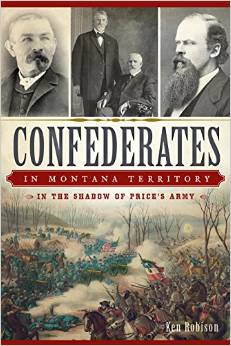Confederates in Montana Territory: In the Shadow of Price’s Army by Ken Robison. The History Press, 2014. Paper, IBSN: 978-1626196032. $19.99.
 “I am so heartily sick of negro rule & Yankee conceit & self sufficiency, that I long to put the sea between this country & myself,” Charles F. Barnes fumed three months after the Civil War’s conclusion. The historical record captures dozens of men who shared Barnes’s sentiment, fantasizing about escape from the ruin of dashed dreams and desolated landscapes by leaving behind the South; they likely spoke for untold thousands more. The vast majority of them vented their resentment, returned to their homes or to nearby portions of the former Confederacy, and set about restoring or recreating their livelihoods, their relationships, and the tenets of white supremacy. Others headed for far-off lands whose political structures enticed with the tempting allure of mastery unbroken by Confederate defeat. Confederate General William W. Loring took his questionable military talents to Egypt, while a few hundred slaveholders dispersed throughout South America, the majority of them putting down roots in Brazil, the final slaveholding republic in the Western Hemisphere.
“I am so heartily sick of negro rule & Yankee conceit & self sufficiency, that I long to put the sea between this country & myself,” Charles F. Barnes fumed three months after the Civil War’s conclusion. The historical record captures dozens of men who shared Barnes’s sentiment, fantasizing about escape from the ruin of dashed dreams and desolated landscapes by leaving behind the South; they likely spoke for untold thousands more. The vast majority of them vented their resentment, returned to their homes or to nearby portions of the former Confederacy, and set about restoring or recreating their livelihoods, their relationships, and the tenets of white supremacy. Others headed for far-off lands whose political structures enticed with the tempting allure of mastery unbroken by Confederate defeat. Confederate General William W. Loring took his questionable military talents to Egypt, while a few hundred slaveholders dispersed throughout South America, the majority of them putting down roots in Brazil, the final slaveholding republic in the Western Hemisphere.
Historians and general audiences have minimized the immense appeal of the American West to former Confederate soldiers, for whom a familiar language, easily obtainable land, and the opportunity to reclaim masculine respect by braving the frontier’s rugged conditions had much to offer. Ken Robison takes up this topic in Confederates in Montana Territory, a collection of biographies of some lively ex-soldiers who found in the far West a second start in life. From the start, they were a motley crew: Robison notes that distant land and wartime gold rushes attracted individual young men who migrated as exiled Confederate prisoners of war “paroled to the western territories”—“Galvanized Yankees” in colorful parlance—or as “deserters and draft evaders,” as well as families who sought to escape violence, guerilla war, and economic ruin following emancipation (19). They quickly established a political truce with territorial elites—including Thomas Francis Meagher, late commander of the Army of the Potomac’s renowned Irish Brigade and no friend to the rebellion—and sought to strike it rich, hoping to find in gold mining camps a tonic that would mitigate the war’s outcome. Montana seemed to promise a new start, one that would allow white southerners and border-staters to ignore as much as possible the economic and political costs of the Confederacy’s defeat. Yet as the mines played out, a return home began to seem more palatable; the majority of ex-Confederates left Montana. By 1870, Robison notes, less than ten percent of Montana residents hailed from south of the Mason-Dixon line.
Those who did remain left a mixed legacy. In a series of biographical sketches, Robison introduces men who fought under the U.S. flag or as militia members in frontier campaigns against the Blackfeet, robbed trains, sought revenge for murders real and imagined, and, more prosaically, set up dry-goods stores and operated hotels. Often, the story is less about Montana in the post-bellum years and more about the wartime lives of Confederates who ultimately found themselves in the territory; Robison spends more than twenty pages—ten percent of his book—reproducing an account of the Battle of Shiloh almost verbatim from the diary of Charles Lilly, a member of Nathan Bedford Forrest’s brigade, and only seven subsequent pages on Lilly’s life in Montana.
This is both an intentional choice and a missed opportunity. A “Lost Cause” ideological interpretation of the Civil War permeates the text; a foreward by Richard F. Thoroughman of the Sons of Confederate Veterans tells readers that we are to learn “the impact of the proud and strong Southern people in the territorial days of Montana” and thereby discern “a true reflection of the Southern character” (9). Robison, a local expert and author of a previous volume on Montana’s Civil War years, seems ideally placed to tell us the unknown story of conflicting ideological worlds, where deserters, diehards, former slaveholders, freed slaves, Irish immigrant veterans of the Union Army fashioned new lives in collision and cooperation with one another. This book might have been a valuable chapter in the growing literature on the messiness of veterans’ postwar lives and of the complexity of the Civil War’s fallout, nationally and globally, in the years after 1865. Instead, this book is about Montanan’s Confederate pasts, rather than Confederates’ Montana lives. These analytical limitations mirror structural shortcomings for those seeking to build on Robison’s research. Lacking footnotes and drawn from an array of secondary historical sources, newspapers from both the nineteenth and twenty-first centuries, genealogical research, and remembrances of Civil War veterans’ living descendants, the book’s documentation offers a poor guide for those who wish to test Robison’s conclusions or expand his purview.
In sum, Ken Robison’s Confederates in Montana Territory shines light on a fascinating, virtually unexplored question: the migration of refugees from the Civil War’s material and ideological carnage to the far reaches of the United States. Civil War scholars and general readers will lament that light’s lack of penetration, precision, or focus; we are left with shadowy impressions, rather than a fixed image, of that historical moment’s contours.
David C. Williard is Assistant Professor of History at the University of St. Thomas.




